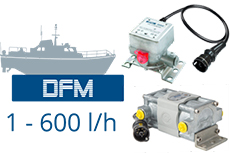
One of the key functions of vessel telematics system – fuel monitoring – helps shipowners and vessel operators to reduce fuel and lubricants expenditures by 30-60%, allows implementing maintenance according to actual condition of vessels and, thereby, extend service life of fuel system.
DFM flow meters are integrated with the ship’s electronic systems over NMEA 2000 protocol.
Explore Technoton cases on vessel fuel monitoring:
- Free port of Ventspils, Latvia – reduction of fuel consumption by 60%.
- Cargo transportation by river transport, Russia – reduction of fleet costs by 50%.
Tasks solved

Live fuel consumption
and operating time monitoring
Live fuel consumption rates detection

Multilevel protection against tampering and interference

Remote engine diagnostics
Fuel flow meters for water transport
The best way to monitor fuel consumption of water transport − is to use direct fuel measurement tools, which provide precise fuel measurement no matter how intensive fuel “bounces” inside tanks/cisterns.
DFM fuel flow meters by Technoton are installed in fuel lines of each fuel consumer (engine, generator, boiler) and provide monitoring of fuel consumption and operating time of each fuel consumer individually.
DFM and DFM D fuel flow meters for small and medium-sized vessels with fuel consumption from 1 to 600 l/h. Measurement inaccuracy is not more than 1%. Fuel counters are mainly used for river and sea-river ships. CAN j1939/S6 output interface allows monitoring 40+ Parameters of fuel consumption and engine operating time.
DFM Marine flow meters for heavy machinery are fuel counters for medium-sized vessels and large ships. Fuel flow meters measure flow rates up to 4,000 L/h with relative accuracy error of fuel measurement not more than ± 0.5%.
Flowmeter’s body is made of duralumin or brass − corrosion-resistant and highly durable material. Fuel line connection types – thread or flange.
DFM Industrial fuel flow meters – big flow meters for large ships with flow rates from 0.72 to 25 m3/h. Measurement inaccuracy is not higher than ± 0.5%. Fuel line connection types – thread or flange. Can be used for heavier grades of fuel (HFO heavy fuel oil or furnace oil) with kinematic viscosity up to 300 cSt.
Wireless DFM S7 fuel flow meter is a convenient solution for small and private fishing and pleasure boats. BLE flow meters do not require laying of power and signal cable; devices transmit data via Bluetooth 4.X. to telematics unit and/or to user’s smartphone and tablet simultaneously.
10 advantages of Technoton DFM flow meters
- Wide range of models for flow rates from 1 to 25,000 l/h.
- Accuracy error from 0.5% to 3% depending on the installation scheme.
- Used for diesel fuel, heating oil, light and heavy fuel oil.
- The maximum temperature of the measured liquid is 150 °C, the viscosity is up to 300 cSt.
- Gathers 40+ Parameters and Counters of fuel consumption and operating time.
- Built-in battery – independence from the on-board power network.
- Measuring chamber is made of zamak/brass, body is made of duralumin or brass.
- Connection to fuel lines – thread or flange.
- Interfaces: CAN j1939/S6, NMEA 2000, Bluetooth, Modbus, pulse.
- Certified by ABS (American Bureau of Shipping) and NMEA (National Marine Electronics Association).




